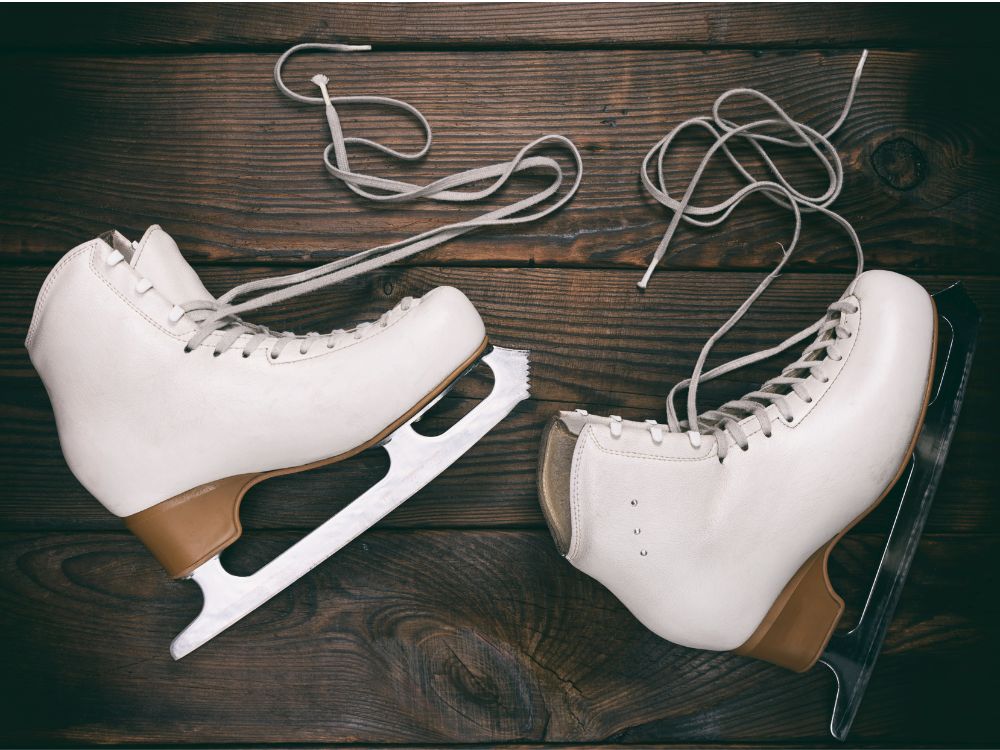Figure skaters need strong glutes. Strong glutes are essential for performing many of the movements in figure skating, including jumps, spins, and lifts. Glutes are also required in almost every skating stroke, including straight forward skating. The glutes are responsible for stabilizing the hips and providing power and explosiveness to movements.
In figure skating, jumps such as the axel and the lutz require a lot of power and force to complete. Figure skaters having strong glutes plays a critical role in generating this power by providing the primary muscle group for hip extension, which is the movement needed to lift the body off the ice during a jump.
Additionally, during spins and lifts, figure skaters need to maintain good posture and balance. A figure skater having strong glutes helps them maintain proper alignment and stability, which is crucial for executing these moves successfully.
In fact, even doing pushes down the ice requires good strength in your glutes. If you think about it, when you push down the rink when skating in a straight line, you push off with your back leg, this involves your glutes in combination with the quads. Then you raise your free leg and keep a nice straight leg line. This is predominantly glutes
Overall, strong glutes are essential for figure skaters to perform at their best, and they are often a focus of strength training programs for skaters.
The glutes and quadriceps (quads) work together to help figure skaters perform many of the movements required in their sport, including jumps, spins, and lifts.
class="wp-block-heading">How the glutes and quadriceps work together in figure skating and why figure skaters need strong glutes
During jumps, the glutes and quads work together to provide the explosive power needed to lift the body off the ice. The quads are responsible for extending the knee joint, while the glutes are responsible for extending the hip joint. These two movements combined generate the power and momentum necessary to complete a successful jump.
In spins, the glutes and quads work together to maintain proper body alignment and balance. Strong glutes help to stabilize the pelvis and prevent excessive movement of the hips during spins, while strong quads help to maintain a stable knee joint and prevent the legs from wobbling.
During lifts, the glutes and quads work together to provide the necessary strength to lift and support a partner’s weight. The glutes provide power and stability for the hips and lower back, while the quads help to support the weight of the partner by maintaining a strong knee joint.
How the glutes and quadriceps work together when skating in a straight line and why figure skaters need strong glutes
As we have discussed, figure skaters need strong glutes for jumps, but strong glutes are also needed when skating in a straight line, the glutes and quadriceps (quads) work together to provide the necessary power, stability, and balance for efficient and effective movement.
The glutes are responsible for extending the hip joint and maintaining proper alignment and stability of the pelvis. As the skater pushes off the ice with one leg, the glutes contract to extend the hip joint, generating power and momentum to propel the body forward. The glutes also play a key role in stabilizing the pelvis during skating, preventing excessive movement and maintaining proper posture and alignment.
The quads, on the other hand, are responsible for extending the knee joint which adds power and momentum to your push (on your pushing leg) and providing support for the body weight during skating (on your skating leg). As the skater pushes off the ice with one leg, the quads contract to extend the knee joint, providing support and stability to the leg and preventing it from collapsing under the weight of the body.
Together, the glutes and quads work in a coordinated manner to generate power and momentum, maintain stability and balance, and prevent injury during skating in a straight line. Strong glutes and quads are essential for efficient and effective skating, and skaters often focus on exercises that strengthen these muscle groups to improve their performance on the ice.
How are the glutes made up?
The glutes, or the gluteal muscles, are a group of three muscles located in the buttocks region of the body. These muscles include the gluteus maximus, gluteus medius, and gluteus minimus.
Gluteus maximus
The gluteus maximus is the single largest muscle in the human body, so yes, its important. It helps to keep the trunk upright, it literally helps to stand us up. It straightens the leg at the hip. So when your leg is bent at the hip, its the gluteus maximus contracting that straightens your leg, so it is fairly obvious that it is a hugely important muscle to a figure skater.
Gluteus medius
The gluteus medius deals with abduction, moving your leg to the side. It also stops your hip dropping when you lift one leg off the ground. The gluteus medius also deals with some of the rotation of the hip and general stability. As figure skaters spend most of their time on one leg or the other, the gluteus medius is hugely important.
Gluteus minimus
The gluteus minimus deals with stability and rotation. It acts as a stabiliser and also functions to internally rotate the joint at the hip.
All of these muscles together make up what we know as the glutes, the butt. They perform different functions, but it all adds up to make a stable, mobile and powerful hip joint.
What exercises to do to increase your glute strength for figure skating?
Well, I am not qualified to give the answer to this, as I am not a clinical professional. In terms of skating, the skating itself will massively increase the use of your glutes. In terms of off ice excercises, there are some qualoified proffesionals online, that have great info on you tube.
Try looking up Jeff Cavaliere MS PT CSCS on the Athleanx channel Jeff received his Masters Degree in Physical Therapy and Bachelor of Science in Physioneurobiology / Premedicine from the University of Connecticut in Storrs, CT.
Another great you tube resource is Dr Krisite Ennis nutritionist, certified strength and conditioning specialist, and physical therapist.
If you liked this article, check out out article on Is yoga good for figure skating?
Disclaimer
I am a figure skater, not a doctor. The information on this page is for information purposes only. If you want proper advice that is true for your physiology then then see a qualified doctor/physio therapist.



